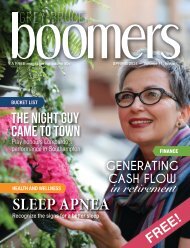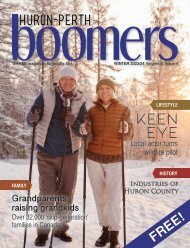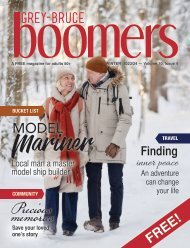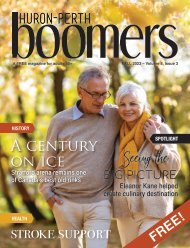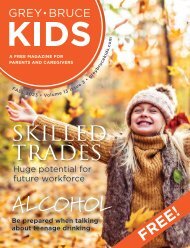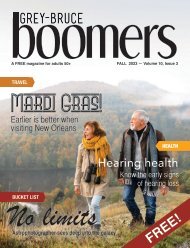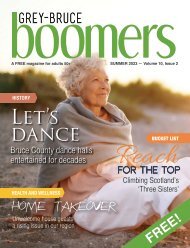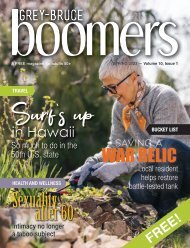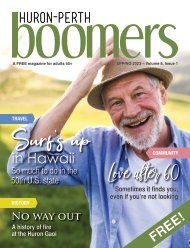Huron-Perth Boomers Spring 2024
You also want an ePaper? Increase the reach of your titles
YUMPU automatically turns print PDFs into web optimized ePapers that Google loves.
A FREE magazine for adults 50+<br />
SPRING <strong>2024</strong> — Volume 9, Issue 1<br />
FINANCE<br />
GENERATING<br />
CASH FLOW<br />
in retirement<br />
TRAVEL<br />
HEALTH AND WELLNESS<br />
SLEEP APNEA<br />
Recognize the signs for a better sleep<br />
B.C.’s finest<br />
Victoria and Vancouver<br />
make the perfect trip<br />
FREE!
Formerly: Mackhall Mobility<br />
Home Health Equipment Solutions<br />
Mobility | Accessibility | Home Safety<br />
CPAP/Sleep Therapy | Personal Care<br />
OntarioHomeHealth.ca<br />
1-800-661-1912
FROM THE PUBLISHER<br />
Ah... spring! Although you may be reading this in March, which is<br />
technically when we welcome spring in <strong>Huron</strong>/<strong>Perth</strong>, it often doesn’t<br />
feel like it. Rest assured, those longer, brighter days are ahead of us.<br />
It is often said that spring is a time of renewal, coming out of months of<br />
cold, dark days but I always liken spring to a ‘New, new year’ – when plans<br />
are being made for the year ahead. There are outside projects to prepare<br />
for, which seem to multiply under the snow, summer vacations to plan, new<br />
activities to sign up for (don’t forget that early registration!), and an overall<br />
sense of feeling hopeful, ambitious and somewhat alive again that coincides<br />
with the reappearance of the sun, grass and birds.<br />
I’m thrilled to share that this issue marks the eighth anniversary of <strong>Huron</strong>-<br />
<strong>Perth</strong> <strong>Boomers</strong>, and I couldn’t be prouder that we have made it this far. I’m<br />
always grateful for our advertisers, writers and readers who continue to<br />
participate in each issue, allowing us to publish the only magazine for adults<br />
50+ in <strong>Huron</strong>/<strong>Perth</strong>.<br />
CONTENTS<br />
Sleep apnea • 4<br />
B.C.’s finest • 8<br />
Preserving memories • 14<br />
Cash flow in retirement • 20<br />
Tiger Dunlop • 26<br />
Recipe • 30<br />
In this issue, we have something of interest for everyone! Jill Ellis-Worthington<br />
takes us along with her to the west coast to explore Victoria and Vancouver,<br />
while Ontario Home Health shares some great information about sleep<br />
apnea. Christine Wiedman also shares her expertise about creating cash<br />
flow in retirement, while local writer and history keeper Arlen Wiebe writes<br />
about the importance of recording your life<br />
story or that of your loved ones. We also get to<br />
know Goderich’s favourite son – Tiger Dunlop.<br />
Thank you for reading and happy spring!<br />
Amy Irwin, Publisher<br />
<strong>Huron</strong>-<strong>Perth</strong> <strong>Boomers</strong><br />
SPRING <strong>2024</strong><br />
Publisher<br />
Amy Irwin<br />
amy@huronperthboomers.com<br />
Magazine Design<br />
Becky Grebenjak<br />
Advertising inquiries<br />
Amy Irwin<br />
amy@huronperthboomers.com<br />
<strong>Huron</strong>-<strong>Perth</strong> <strong>Boomers</strong> welcomes<br />
your feedback.<br />
EMAIL<br />
amy@huronperthboomers.com<br />
PHONE 519-524-0101<br />
MAIL<br />
P.O. Box 287, Ripley, ON N0G 2R0<br />
<strong>Huron</strong>-<strong>Perth</strong> <strong>Boomers</strong> is distributed for free in <strong>Huron</strong> and <strong>Perth</strong><br />
counties, and is published each March, June, September, and<br />
December. Distribution of this publication does not constitute<br />
endorsement of information, products or services by <strong>Huron</strong>-<strong>Perth</strong><br />
<strong>Boomers</strong>, its writers or advertisers. Viewpoints of contributors and<br />
advertisers are not necessarily those of the Publisher. <strong>Huron</strong>-<strong>Perth</strong><br />
<strong>Boomers</strong> reserves the right to edit, reject or comment on all material<br />
and advertising contributed. No portion of <strong>Huron</strong>-<strong>Perth</strong> <strong>Boomers</strong> may<br />
be reproduced without the written permission of the Publisher.
HEALTH AND WELLNESS<br />
SLEEP<br />
APNEA<br />
RECOGNIZING THE SIGNS AND TAKING ACTION<br />
BY TRACY GEORGE<br />
4 • HURONPERTHBOOMERS.COM
y Tracy George<br />
HEALTH AND WELLNESS<br />
Sleep apnea is a common, yet often undiagnosed, sleep<br />
disorder that can have serious health implications if left<br />
untreated. It’s crucial to recognize the signs and symptoms<br />
and take appropriate action.<br />
In this article, we’ll discuss how to identify if you have sleep<br />
apnea and what steps to take if you suspect you may be<br />
affected.<br />
What is sleep apnea?<br />
Sleep apnea is a condition characterized by interrupted<br />
breathing during sleep. There are two primary types of<br />
sleep apnea – Obstructive Sleep Apnea (OSA), which is the<br />
most common type. It occurs when the throat muscles relax<br />
excessively, obstructing the airway during sleep. The other<br />
type is Central Sleep Apnea, which is less common and results<br />
from a failure of the brain to send the proper signals to the<br />
muscles responsible for controlling breathing.<br />
SPRING <strong>2024</strong> • 5
HEALTH AND WELLNESS<br />
by Tracy George<br />
Recognize the signs<br />
Identifying the symptoms of sleep apnea is the<br />
first step toward diagnosis and treatment. Here are<br />
common signs to look out for:<br />
Loud and persistent snoring. If you or your<br />
sleep partner snores loudly and frequently, especially<br />
with intermittent pauses in breathing, it may be a<br />
sign of sleep apnea.<br />
Frequent awakening. If you find yourself waking<br />
up gasping for breath or experiencing a choking<br />
sensation during the night, this could be indicative<br />
of sleep apnea.<br />
Excessive daytime fatigue. One of the hallmark<br />
signs of sleep apnea is excessive daytime sleepiness,<br />
even after a full night’s sleep.<br />
Morning headaches. Waking up with frequent<br />
morning headaches, especially if they are severe,<br />
may be related to sleep apnea.<br />
Difficulty concentrating. Poor focus and<br />
difficulty concentrating on tasks can result from sleep<br />
deprivation caused by untreated sleep apnea.<br />
High blood pressure. Sleep apnea is linked to<br />
hypertension and cardiovascular problems, so if<br />
you have high blood pressure, consider it a potential<br />
risk factor.<br />
Suspect sleep apnea?<br />
If you recognize the signs of sleep apnea in yourself<br />
or a loved one, it’s essential to take action promptly.<br />
Here are the steps to follow:<br />
Consult a health care professional. The first<br />
step is to discuss your symptoms with a health care<br />
provider, ideally a sleep specialist or pulmonologist.<br />
You will need to discuss with your family doctor to<br />
get a referral.<br />
Undergo a sleep study. This will monitor your<br />
sleep patterns, breathing, and other essential<br />
parameters to confirm the diagnosis.<br />
6 • HURONPERTHBOOMERS.COM
y Tracy George<br />
HEALTH AND WELLNESS<br />
Explore treatment options. If diagnosed with<br />
sleep apnea, your health care provider will discuss<br />
treatment options. Common approaches include<br />
lifestyle changes, such as weight loss and positional<br />
therapy, and the use of Positive Airway Pressure<br />
(PAP/CPAP) device.<br />
Compliance and follow-up. If prescribed PAP or<br />
other treatments, it’s crucial to use them consistently<br />
and attend follow-up appointments to monitor<br />
progress and make necessary adjustments.<br />
Recognizing the signs of sleep apnea and seeking<br />
treatment is vital for your overall health and wellbeing.<br />
By taking these steps, you can improve your<br />
quality of life, reduce the risks associated with sleep<br />
apnea, and regain restful, uninterrupted sleep.<br />
Tracy George is a Sleep Therapy Manager at Ontario Home<br />
Health. For more information, call 1-800-661-1912, visit<br />
www.OntarioHomeHealth.ca, or visit one of their six locations.<br />
GRANDPARENTS RAISING<br />
GRANDCHILDREN<br />
Peer support group for<br />
grandparent caregivers<br />
education • community • support<br />
Learn more here:<br />
www.rrhc.on.ca/grandparentsraisinggrandchildren<br />
SPRING <strong>2024</strong> • 7
TRAVEL<br />
B.C.’s finest<br />
VANCOUVER AND VICTORIA MAKE THE PERFECT<br />
COMBO FOR A VISIT TO CANADA’S WEST COAST<br />
STORY AND PHOTOS BY JILL ELLIS-WORTHINGTON<br />
Above: Colourful floating homes line the<br />
docks of Victoria’s Fisherman’s Wharf.<br />
Right: Ralph Lembcke and Jill Ellis-<br />
Worthington ready to challenge the<br />
suspension bridge at Lynn Canyon.<br />
8 • HURONPERTHBOOMERS.COM
y Jill Ellis-Worthington<br />
TRAVEL<br />
There are many places around the world where<br />
you can look one way to see the ocean and the<br />
other way to see mountains. Aren’t we lucky that<br />
Canada’s most westerly province is one of them?<br />
Canadians’ interest in travelling inside the country<br />
has been reignited, partially sparked by the pandemic.<br />
We’re finding ways to explore our home that tourists<br />
from all over the world come to see.<br />
Last summer, low-priced Flare Airlines started<br />
flying non-stop from London, Ont., to Vancouver.<br />
Not having a layover in Calgary shortens the trip<br />
considerably, and the cheaper fare is nice because<br />
flights to both Vancouver and Victoria can be pricey.<br />
When you land at Vancouver International Airport,<br />
taxis will be waiting to whisk you to your lodgings,<br />
but Uber and Lyft drivers are plentiful in the nation’s<br />
third-largest city, and it’s good to know the price of<br />
the ride before you start. Once you’re settled at a<br />
hotel or Airbnb, using the Skytrain to get around is<br />
fast, clean and easy. Buying a Compass card at one<br />
of the stations makes getting around even cheaper.<br />
Note, the card costs $6 and then you load it up with<br />
rides as needed, but you can mail it back to get a<br />
refund.<br />
B.C. recently outlawed entire-home Airbnbs,<br />
but you can still use this less expensive option for<br />
accommodations by choosing one that is a separate<br />
suite or room in a home in both Vancouver and<br />
Victoria. We found one with a private suite in a home<br />
just a three-block walk from the Nanaimo Skytrain<br />
station.<br />
In Victoria, where there are many sumptuous<br />
places to stay, Dayna Wilson, who lives just outside<br />
of London, Ont., recommends the Days Inn by<br />
Wyndham on the Harbour as a cheaper alternative.<br />
She says it’s about half the price of “swankier”<br />
places.<br />
“It has a great view, has been updated, is clean and<br />
the staff were great,” Dayna said.<br />
In any large city, taking a hop-on-hop-off tour gives<br />
a wonderful overview and a taste of what’s worth<br />
experiencing fully when you have more time. We<br />
hopped on a Gray Line ‘trolley’ (a retired school<br />
bus) that took us around a loop that included Stanley<br />
Park, Granville Island, Chinatown and Gastown,<br />
along with many other lesser-known stops. The<br />
antiquated sound system made it hard to understand<br />
the drivers at times, but we liked sitting in the openair<br />
portion of the bus.<br />
Granville Island is one of the places you will want to<br />
explore further, so board an aqua bus at one of the<br />
eight stops on False Creek. The ‘island’ was created<br />
after the creek was dredged and became home to<br />
Vancouver’s industrial area. Many buildings have<br />
been repurposed and now house the renowned<br />
SPRING <strong>2024</strong> • 9
TRAVEL<br />
by Jill Ellis-Worthington<br />
Clockwise from left: The steam-powered clock<br />
in Vancouver’s Gastown. History buffs will enjoy<br />
Craigdarroch Castle in Victoria. The colourful, rolling<br />
grounds of Queen Elizabeth Park provide a respite in the<br />
middle of noisy Vancouver. The Fairmont Empress Hotel<br />
is one of Victoria’s iconic sites.<br />
Opposite: On the bow of one of the Prince of Whales’<br />
whale-watching boats, the author and her husband were<br />
happy to see humpbacks and orcas during their excursion.<br />
10 • HURONPERTHBOOMERS.COM
y Jill Ellis-Worthington<br />
TRAVEL<br />
Public Market. Take your appetite because there are<br />
dozens of delicious treats to consume while shopping<br />
in the many quaint shops. The lemon squares and<br />
canelés were particularly tasty. It was fun browsing<br />
in the broom shop and thinking about how Harry<br />
Potter would love it there. In a stall with imported<br />
rugs, I got an amazing bargain on a lovely deep<br />
teal pashmina a few doors down from other shops<br />
charging three or four times as much for the same<br />
thing. There are unique items and good prices if you<br />
hunt a bit. Give your shoes a rest by stopping at the<br />
Granville Island Brewing or the waterside patio at<br />
Tap & Barrel Bridges.<br />
On everyone’s must-go list, Stanley Park sits on 1,000<br />
acres in the west end. While the hop-on-hop-off bus<br />
ride through was good, we really enjoyed going back<br />
and renting bicycles to explore it further. One of the<br />
most convenient places to rent them is at Spokes on<br />
West Georgia Street, just two blocks from one of the<br />
park’s entrances. A shared path circumnavigates;<br />
walkers don’t always stick to their section, so caution<br />
is advised. Electric-assist bikes enabled us to go<br />
around the park twice, as well as explore some of the<br />
hillier interior paths. Riding under the Lions Gate<br />
Bridge and stopping to wade at Third Beach were a<br />
couple of highlights. Stanley Park Brewpub makes<br />
a great stopover for lunch and a libation to fuel the<br />
ride.<br />
For a cheap, active afternoon, we decided to visit<br />
Lynn Canyon, a lovely green oasis. At Canada Place,<br />
we took the Aquabus Ferry to North Van and jumped<br />
on a bus (both covered by our transit passes) to the<br />
neighbourhood adjacent to the canyon. A short walk<br />
took us to the edge of the park. After picking up a map<br />
at the visitors’ centre, we chose the three-kilometre<br />
trail that took us over the Suspension Bridge, past<br />
the Lynn Creek swimming hole, and back around<br />
to the entrance. There are longer and shorter trails;<br />
this seemed a good choice for my knees, but it can<br />
be challenging to hike over the rocky terrain and up<br />
several sets of steep wooden stairs. It wasn’t always<br />
fun, but the stunning beauty of the rainforest made<br />
it more than worthwhile, and all for free. Two other<br />
freebies include Chinatown and Queen Elizabeth<br />
Park. Walk through Chinatown to experience its<br />
architecture and food, and don’t miss the world’s<br />
narrowest commercial building (Sam Kee Building)<br />
or the peaceful Dr. Sun Yat-Sen Classical Chinese<br />
Garden. Queen Elizabeth Park is a serene spot in the<br />
middle of a busy area of town, offering the best view<br />
of Vancouver from a lofty 125 metres above the city.<br />
A walk through the 52-hectare gardens adds to the<br />
enjoyment.<br />
The journey to Victoria starts with a 90-minute ferry<br />
ride to Vancouver Island, during which you may even<br />
see whales. Since neither Vancouver nor Victoria are<br />
close to the ferry terminals on either end, we found<br />
taking a Viator ‘tour’ the cheapest way to do it. A<br />
bus picks you up at historic Pacific Central Station<br />
and takes you onto the ferry. On the other side, it<br />
drives you to downtown Victoria for one lower price<br />
as opposed to paying for the ferry and taxis or ride<br />
shares at each end.<br />
Victoria is a walkable city; we didn’t pay for<br />
transportation during our visit. Much of the action<br />
is centered around the inner harbour. Strolling its<br />
perimeter takes you by the famed Fairmont Empress<br />
SPRING <strong>2024</strong> • 11
TRAVEL<br />
Queen Elizabeth Park offers the best view of<br />
Vancouver from 125 feet above sea level.<br />
Hotel and around to the Legislative Assembly of<br />
British Columbia, with its architectural style most<br />
often described as “free classical,” Romanesque or<br />
Renaissance. Check out the lovely old buildings of<br />
the latter, and the grounds of the former.<br />
Downton Abbey fans will relish a self-guided tour<br />
of Craigdarroch Castle. While not nearly as grand<br />
as the Earl of Grantham’s residence, strolling the<br />
‘castle’ halls and climbing the separate staircases used<br />
by family and servants gives a sense of yesteryear. A<br />
short walk from the castle takes you to the grounds<br />
of Government House, the official residence of<br />
B.C.’s Lieutenant Governor. Walking through the<br />
expansive gardens is free, as opposed to paying to<br />
tour Butchart Gardens.<br />
Founded in 1862, Victoria is one of the nation’s<br />
oldest cities; its architecture exhibits a storied past.<br />
To experience it on the cheap, pick up self-guided<br />
heritage walking tour maps at Victoria’s Visitor Centre<br />
located on the harbour. They cover fun subjects like<br />
Haunted Victoria, Rollicking Boomtown, Law and<br />
Order and Mysterious Chinatown, which was once<br />
the largest in Canada and is well worth exploring.<br />
Hidden alleyways and exotic-looking buildings<br />
beckon visitors.<br />
A walk down pedestrian-friendly Government Street<br />
is good for people watching, appreciating buskers<br />
and window shopping. So many quaint eateries<br />
reside in this tourist-magnet district.<br />
While at the harbour, you’ll see little taxi and harbour<br />
tour boats scuttling along, and you can pick up tickets<br />
at the kiosk on the Empress dock. The captains relate<br />
tales of the harbour’s colourful history and geography.<br />
We jumped off at Fisherman’s Wharf to grab a bite to<br />
eat at one of the many floating restaurants and joined<br />
the crowds checking out the charming floating homes<br />
docked there.<br />
Walking along the waterfront area, you can’t help<br />
but notice all the businesses offering whale watching<br />
tours, and we chose the Prince of Whales. It offers<br />
both zodiac and catamaran tours – we picked the<br />
latter because of its more stable ride and bathrooms.<br />
This excursion was a splurge but well worth the<br />
cost. We sat on the bow, giving us the best view of<br />
the magnificent scenery as we skiffed the waters<br />
12 • HURONPERTHBOOMERS.COM
y Jill Ellis-Worthington<br />
of the Strait of San Juan de Fuca. The crew kept<br />
us informed of where to look for whales. We were<br />
fortunate enough to be in good viewing distance of<br />
a humpback and several orcas, including a baby.<br />
So that you can enjoy the experience fully without<br />
fiddling with your phone, the staff photographer<br />
takes pictures that are shared with all guests on that<br />
trip via a link.<br />
FREE<br />
Hearing<br />
Test *<br />
Love your ears<br />
Professionals<br />
in hearing<br />
& living a full life<br />
Taking a float plane back to Vancouver to catch<br />
our flight to Ontario was a breathtaking once-in-alifetime<br />
experience.<br />
Recommended restaurants<br />
Vancouver<br />
• Fat Mao Noodles (fantastic bowls)<br />
• Chinatown BBQ (best fried rice I’ve ever had)<br />
• Little Bangkok Thai Kitchen (rated best Thai in<br />
Vancouver. Twist: it’s in a mall)<br />
• VJ’s Restaurant (excellent high-end Indian cuisine).<br />
• Sulbing Café Robson (bingsu – amazing Korean<br />
shaved milk dessert)<br />
• Local Public Eatery (great patio, Gastown)<br />
• Blue Fox (delicious breakfasts and mimosas)<br />
Victoria<br />
• Bard and Banker Pub on Government Street<br />
(charming and historic)<br />
• Lido Waterfront Bar (sit and watch the boats)<br />
• Floyd’s Diner (best breakfast and worth the wait)<br />
• Gozen Sushi (best miso)<br />
• Ocean Garden Restaurant (good and in the heart<br />
of Chinatown)<br />
• The Fish Store (best on Fisherman’s Wharf)<br />
• Chocolats Favoris (decadent dipped cones)<br />
A writer, public relations professional, traveller and football<br />
fan, Jill Ellis-Worthington celebrates life every day. You can<br />
follow her blog at writeoncommunicationservices.com.<br />
Being able to hear is central to who you are, and<br />
hearing aids play a crucial role in helping your<br />
brain process sound.<br />
This helps you to engage effortlessly with the<br />
world around you, foster meaningful connections<br />
and most importantly, keep being you!<br />
Why Choose<br />
90-DAY<br />
risk free purchase,<br />
no return fees<br />
FULL-SERVICE<br />
WARRANTY<br />
Get started with a FREE hearing test today!*<br />
Listowel 1195 Wallace Avenue<br />
Wingham 3 Patrick Street<br />
Goderich 394 <strong>Huron</strong> Road, Unit 3<br />
Clinton 89 Albert Street, PO box 751<br />
Exeter 281 Main Street S, Unit 277<br />
Stratford<br />
<strong>Huron</strong> 295 <strong>Huron</strong> Street<br />
Cambria Professional Building 386 Cambria Street<br />
1-888-788-5302<br />
Mention code:<br />
PRICE 350+<br />
match policy ** clinics across<br />
Canada<br />
Book online<br />
HearingLife.ca<br />
Your hearing aid purchase<br />
goes beyond the point of sale<br />
NSP-FHT-HPBM<br />
*A comprehensive hearing assessment is provided to adults ages 19 and older at no cost. The results of<br />
this assessment will be communicated verbally to you. If you request a copy of the Audiological Report, an<br />
administrative fee will apply. Child hearing tests are conducted at select locations for a fee, please contact<br />
us for more information. 90-Day Risk-Free Trial begins at the date of purchase. Information within this offer<br />
may vary or be subject to change. Limit one offer per customer per year. Offer not valid in Quebec. Offer not<br />
applicable for industrial hearing tests. Some conditions apply, see clinic for details. **If you are quoted a lower<br />
price on an identical hearing aid with the same features, options and services, HearingLife Canada Ltd. will<br />
match that price. Conditions Apply. Ask our hearing care professionals for more details.<br />
SPRING <strong>2024</strong> • 13
COMMUNITY<br />
Saving your<br />
Memories<br />
THE “WHY” AND “HOW” OF SAVING YOUR PRECIOUS<br />
RECOLLECTIONS BY ARLEN WIEBE<br />
14 • HURONPERTHBOOMERS.COM
y Arlen Wiebe<br />
People have always been captivated by a<br />
compelling story. Since the birth of language,<br />
people from all cultures have been telling stories that<br />
both instruct and entertain.<br />
Long ago, people gathered around a fire at the end of<br />
a long day to hear myths, legends, fables, epic poems,<br />
proverbs, chants, rhymes, and songs. Storytellers<br />
preserved and passed a community’s stories down<br />
the generations.<br />
A big shift occurred when people created written<br />
language to record spoken words. People weren’t<br />
completely dependent on a community storyteller to<br />
preserve the oral stories anymore. With the printing<br />
press, books could be easily mass produced, and<br />
more people learned to read.<br />
Today, another huge shift has occurred. Instead of a<br />
communal experience around a living fire, families<br />
now congregate facing a glowing electronic screen.<br />
The storytelling task seems to be taken over by<br />
filmmakers and television writers.<br />
Why are stories so powerful?<br />
It’s incredibly fortunate that stories are both<br />
instructive and entertaining. While it might be<br />
possible to commit bits of knowledge to memory<br />
if we try hard enough, stories help us engage with<br />
our history, traditions and values much more easily.<br />
COMMUNITY<br />
Stories help us to create order and make sense of our<br />
lives. They help us appreciate how other people think<br />
and feel. Stories use language in a way that is unlike<br />
our everyday way of speaking and writing. Stories<br />
fashion ordinary words and events into extraordinary<br />
dramas.<br />
Should you record your stories?<br />
Yes! Our personal stories can be extremely valuable to<br />
ourselves and our families. We can preserve important<br />
family stories for our children and grandchildren. We<br />
can gain insight into our struggles and choices and<br />
share our wisdom. We can find direction for the rest<br />
of our lives and heal, especially if our lives have been<br />
shaped by pain or tragedy. We can connect names<br />
and stories to old family photos or add details to the<br />
family tree.<br />
Have you ever thought you’d like to know what your<br />
ancestors’ lives were really like, in their own words?<br />
Consider how your own life will be interesting to<br />
your descendants. Even people that don’t know us<br />
may be interested in our stories. Many people enjoy<br />
reading the personal anecdotes, stories and essays<br />
in the “First Person” section of The Globe and Mail.<br />
Maclean’s magazine publishes “My Arrival: The Lives<br />
of New Canadians” on the last page of each issue.<br />
CBC posts personal stories and experiences in its<br />
online “First Person” columns.<br />
SPRING <strong>2024</strong> • 15
COMMUNITY<br />
by Arlen Wiebe<br />
I’ve started writing about my own childhood<br />
experiences and coming to terms with how they have<br />
affected my adult life.<br />
A Canadian boy in California<br />
I could see my boyhood coming to an end when I<br />
was 12 years old. The curious warmth of springtime<br />
in Winnipeg had come back like a long-lost relative<br />
returning from a freezing and miserable journey.<br />
Light green leaves were budding once more on<br />
ancient elm trees as I walked south along Arlington<br />
Street, turned west onto Wolseley Avenue, and<br />
begrudgingly arrived at my weekday destination,<br />
Laura Secord School.<br />
Like all boys of school age should be, I was in a<br />
terrible hurry for the unbearable monotony of<br />
the daily academic ordeal to be done for the year.<br />
I was exhausted from trying to speak and write<br />
in my teacher’s funny foreign language. Pourquoi<br />
apprenais-je le français when my forebears spoke<br />
Plautdietsch, Nederlands, or Russki yazyk and wrote<br />
in Hochdeutsch? Other kids in my class came from<br />
families that spoke even more exotic languages. Why<br />
were we all being forced to learn a language not one<br />
of our families had ever spoken and likely never<br />
would?<br />
And why this inanely prescribed schedule? All this<br />
writing, reading, presenting, doing, and going here<br />
and there at the same time every day. Had the<br />
adults who ran the school given a maniacal villain<br />
permission to set up a labyrinth of torture? Why were<br />
we tested for our ability to remember the random<br />
order of letters in words or how numbers changed<br />
themselves when they met the funny symbols on the<br />
page?<br />
Once the clock on the classroom wall was finally<br />
persuaded to place a short stingy hand on the<br />
number three and its longer hand on six, I fled the<br />
prison and quickly reversed the route I had slowly<br />
walked that morning.<br />
Once at home, I put on a blue jersey, white pants,<br />
and cap and held my baseball glove in my hand.<br />
I finally felt free of all restraints. My mother had<br />
mercifully signed me up for a team through the R.A.<br />
Steen Community Centre, located on the far end of<br />
the field behind my school. We played our games in a<br />
sunken double baseball diamond circled by a gravel<br />
walking and biking path, near Omand’s Creek.<br />
I tried all the baseball positions in the field but I<br />
most enjoyed pitching. Standing high on an elevated<br />
mound. Controlling the start of each play. Deciding<br />
where to place the baseball to the waiting batters.<br />
I always held the baseball with the fastball grip. I<br />
hadn’t been taught how to throw any other kinds of<br />
pitches. Instead of variety, I tried to throw the same<br />
pitch again and again, laser focused on the shifting<br />
strike zone. Sometimes the ball would thread through<br />
that invisible rectangle between the elbows and knees<br />
of the cocky boy poised at home plate. Other times,<br />
it flew out of control, avoiding that rectangle, and<br />
rolling to the chain link fence behind our catcher.<br />
Most of my pitches flew past the boys at the plate.<br />
On the rare occasion when the batter made contact<br />
with the ball, my teammates organized themselves<br />
around the ball, stopped it, and threw it to first base.<br />
Midway through the baseball season, my mother<br />
got an emotional phone call. My absent father<br />
lay dying in a Regina hospital. She and I dropped<br />
everything and immediately drove 600 kilometres<br />
west across Manitoba and Saskatchewan to visit the<br />
man my mother had once given her heart to and<br />
that we barely knew anymore. When we entered<br />
my father’s hospital room, I saw a sickly, shriveled<br />
man in a hospital gown. He could barely sit up in his<br />
bed to greet us. Who was this person? I stood there<br />
stoically, listening to my parents catching up on years<br />
of missed time together.<br />
My father had three brothers. His brother Jake, from<br />
B.C., came with his wife and two kids to visit in<br />
16 • HURONPERTHBOOMERS.COM
y Arlen Wiebe<br />
COMMUNITY<br />
the hospital. Once his daughter, Shalom, had seen<br />
my father and left the room, she started to sob in<br />
the hallway. I watched her from my dad’s bedside.<br />
Why was she so upset? It wasn’t her father dying, it<br />
was mine. If anyone should be worked up, it should<br />
be me. I looked inside myself to find something<br />
that matched my cousin’s emotion but there was<br />
nothing there.<br />
We returned to Winnipeg and the baseball season<br />
continued. A few weeks later, there was another<br />
difficult phone call. We buried my father beside a<br />
little country church on the Saskatchewan prairie.<br />
Soon after, my mother was very surprised to receive a<br />
large payment from my father’s life insurance policy<br />
that had been kept active. This set the gears in motion<br />
for my mother’s next step. She had always dreamed<br />
of studying to become a pastor and now she had the<br />
money to do it. She wanted to study at a seminary in<br />
California. All that summer, my mother prepared us<br />
to move. I was devastated. I didn’t want to live in a<br />
foreign country without friends or anything familiar.<br />
In late August, my mother and I boarded an airplane<br />
that took us from Winnipeg to Minneapolis, then on<br />
to Los Angeles. We crossed that huge airport to catch<br />
a tiny airplane to take us to Fresno. We moved into<br />
a small apartment on the campus where my mother<br />
would study the Bible and theology.<br />
I would attend school as a light-skinned Canadian<br />
among a sea of black and brown faces. I would<br />
travel to Yosemite National Park, San Francisco, and<br />
Hollywood. I would be forced to adapt to many new<br />
things as I started Grade 7. My Canadian boyhood<br />
had come to an end in California.<br />
Learn how we make clean energy and medical<br />
isotopes at the Bruce Power Visitors’ Centre.<br />
Wonder.<br />
Explore.<br />
Discover.<br />
www.brucepower.com/visit<br />
3394 BRUCE ROAD 20, NORTH OF TIVERTON, WEST OF HIGHWAY 21. T: (519) 361-7777<br />
SPRING <strong>2024</strong> • 17
COMMUNITY<br />
by Arlen Wiebe<br />
to hear you telling your stories with your own voice.<br />
Would you enjoy hearing stories told in the voices of<br />
your ancestors?<br />
Books – A book can be narrative only or it can<br />
feature photos, documents, and other illustrations.<br />
Books can be paperback or hardcover, simple or<br />
elegant.<br />
What all is involved?<br />
Recording your personal stories is a way to connect<br />
generations and preserve memories. Sometimes<br />
called a personal history, it could be a memoir, a<br />
tribute, a life story, a family biography, an oral history,<br />
a legacy letter, or ethical will.<br />
If you work on your own personal history or that of<br />
a loved one, your only cost is your time and expenses.<br />
If you hire a personal historian, the cost will range<br />
in price from a few hundred dollars (audio and/or<br />
transcripts for oral history), to thousand dollars (a life<br />
story with photos), to tens of thousands of dollars<br />
(longer or more complex projects).<br />
What format does personal<br />
history take?<br />
A childhood<br />
photo of<br />
Arlen and<br />
his Mom.<br />
Personal histories can be recorded in many ways.<br />
Here are some areas in which personal historians<br />
may have expertise.<br />
Audio recordings/CDs – Recording your stories<br />
electronically in an audio file or a CD allows your<br />
children, grandchildren, and great-grandchildren<br />
Art books, scrapbooks, handmade books –<br />
These are one-of-a-kind products that can include<br />
written stories, photos, drawings, scraps of fabric,<br />
pressed flowers, jewelry, and any other kind of valued<br />
memento.<br />
Photo books, collages, calendars – These<br />
products are mostly photos or drawings combined<br />
with very few written words. You could create a<br />
beautiful photo book, a poster-sized collage, or a<br />
photo calendar with pictures of family members<br />
included on their birthdays, anniversaries, or other<br />
important dates.<br />
Photo videos – You can use photos, home movies,<br />
slides, videotapes, and other memorabilia to create a<br />
memorable video set to music.<br />
DVDs – You can capture a person’s voice, personality,<br />
gestures, and spirit for posterity on video. This<br />
kind of project can be simple or complex, include<br />
individual or group interviews, and range from short<br />
tribute to TV-style biography.<br />
Ethical wills or legacy letters – An ethical<br />
will or legacy letter is a statement of your personal<br />
values, beliefs, life lessons, and a message you want to<br />
convey to your family, friends, and community.<br />
Legacy planning – Legacy planning helps<br />
you preserve your values and heritage for future<br />
generations. Tasks might include taking care of<br />
historical family documents and photos, creating<br />
an archive, preparing material for an obituary, or<br />
memorial service planning.<br />
18 • HURONPERTHBOOMERS.COM
y Arlen Wiebe<br />
COMMUNITY<br />
Family websites – It’s becoming increasingly<br />
popular for families to create a website to preserve<br />
and share family stories and information. These<br />
sites might include a family tree, genealogy, photos,<br />
letters, stories, videos, and sound files.<br />
Unique products – Some people enjoy being<br />
creative with their precious memories. A special<br />
quilt could be made of valued fabrics or decorations.<br />
Inspiring images and music can lead to a painting,<br />
drawing, mural, collage, memory box or multimedia<br />
presentation. Valued recipes could be collected into<br />
a family cookbook. What else could you imagine?<br />
Tell your story<br />
People now recognize that reminiscence and life<br />
review are important life processes. Working through<br />
our memories to find patterns, meaning, and values<br />
are key to a fully examined life. Many of us think<br />
about interviewing our aging family members but<br />
put it off until later. When we finally find the time, it<br />
may be too late – the loved one could be too frail to<br />
tell their stories, or their memories may have faded.<br />
Worse, they may have already passed away.<br />
If recording your own stories or that of a loved one is<br />
important to you, take the first step today to making<br />
it happen!<br />
Arlen Wiebe is a personal historian, writer, musician, and<br />
teacher living in Owen Sound. He enjoys helping people find<br />
meaning and purpose through writing their life stories, memoirs,<br />
and family history. You can learn more about him at yourlife-stories.ca.<br />
You can contact him by email at arlen.wiebe.<br />
writer@gmail.com or by text/phone at 226-668-3352.<br />
SPRING <strong>2024</strong> • 19
FINANCE<br />
GENERATING<br />
CASH FLOW<br />
in retirement<br />
TOO OFTEN, FINANCIAL ADVICE ONLY<br />
FOCUSES ON SAVING MONEY<br />
BY CHRISTINE WIEDMAN<br />
20 • HURONPERTHBOOMERS.COM
y Christine Wiedman<br />
FINANCE<br />
Throughout your career you were advised to save<br />
for your retirement, so you did. You opened<br />
a Registered Retirement Savings Plan (RRSP) and<br />
later a Tax-Free Savings Account (TFSA). The<br />
government also required you to make contributions<br />
to the Canada Pension Plan (CPP) each paycheque.<br />
You may have contributed to a company pension<br />
plan, and saved money in a non-registered account<br />
like a brokerage account through your bank. You<br />
became a very good saver. Perhaps you had a goal<br />
in mind for how much you needed to save for<br />
retirement, although you likely wondered if that goal<br />
was enough.<br />
Now you have retired, and that’s great! You no<br />
longer have to save and now you can start spending<br />
those hard-earned dollars. Life is good, right? Yet, at<br />
the same time you’ve found freedom, your financial<br />
life becomes much more complicated. You have to<br />
shift from automatically receiving a paycheque to<br />
creating a cashflow management plan to meet your<br />
needs. You have entered a whole new territory of<br />
personal finance.<br />
The cash flow you generate in retirement will likely<br />
not come from one source, such as a paycheque.<br />
Instead, you will be managing multiple sources of<br />
potential cashflow. Some of these sources already<br />
come in the form of a periodic payment, like<br />
government benefits – CPP, Old Age Security (OAS)<br />
and possibly the Guaranteed Income Supplement<br />
(GIS) for low-income Canadians – or a workplacedefined<br />
benefit pension. A big advantage of<br />
government benefits and many company pensions is<br />
that they are indexed to inflation, so you don’t have<br />
to worry about the purchasing power of your money<br />
eroding over time. The remainder of your cash flow<br />
SPRING <strong>2024</strong> • 21
FINANCE<br />
by Christine Wiedman<br />
will come from your assets, including equities and<br />
fixed income securities saved in your registered and<br />
non-registered accounts. But how do you convert<br />
these assets into cashflow?<br />
Meet “Phil and Prya”<br />
Take Phil and Prya (not real people) as an<br />
example. They are both 65 and have just retired.<br />
Phil contributed the maximum amount to CPP<br />
throughout his career, and is therefore entitled to the<br />
maximum benefit of $15,679 per year. He decides<br />
to start taking CPP right away. Prya did not earn as<br />
much as Phil so she is entitled to $7,840 per year. 1<br />
She was employed by the government for part of<br />
her career, and is entitled to government pension of<br />
$12,000 per year. If we assume that neither will have<br />
income exceeding $81,761 (2022) thereby avoiding<br />
OAS claw-backs, and have both lived in Canada<br />
their entire working lives, they will each be entitled to<br />
the maximum OAS of $8,383 per year. This brings<br />
their total pre-tax income to $52,285. All of these<br />
amounts are indexed to inflation and therefore will<br />
increase over time.<br />
Cash flow needs and pre-tax income<br />
Where should Phil and Prya go from here? First,<br />
they need to know how much they will likely spend<br />
each year. A detailed review of their spending in the<br />
past year could help them estimate their cashflow<br />
needs. Let’s assume they will need about $70,000 of<br />
after-tax cashflow in their first year of retirement.<br />
Assuming each pays taxes of about 15 per cent,<br />
this translates to about $82,000 of required pre-tax<br />
income. 2<br />
“Pensionizing” your assets<br />
The good news is that over 60 per cent of their<br />
cashflow needs will come from guaranteed payments<br />
that are indexed to inflation. However, they still need<br />
to generate about $30,000 per year to meet their<br />
retirement spending goals. To do this, they will have<br />
to convert their existing assets into cash flow. Authors<br />
Moshe Milevsky and Alexandra Macqueen coined<br />
the term to “pensionize” your nest egg to describe<br />
the problem, and defined it as converting money<br />
into income you can’t outlive; and creating your own<br />
personal pension, a monthly income that lasts for the<br />
rest of your life. 3<br />
Assets can include savings accounts, Guaranteed<br />
Investment Certificates (GICs), corporate and<br />
government bonds, individual stocks, mutual funds,<br />
and Exchange Traded Funds (ETFs). 4 They may<br />
be accumulated in your TFSA, which is exempt<br />
from tax, in tax-deferred vehicles like your RRSP<br />
or Registered Retirement Income Fund (RRIF), in<br />
workplace-defined contribution plans, or in nonregistered<br />
accounts like a brokerage account.<br />
So how do you convert these assets into a regular<br />
cash flow? Let’s assume that Phil has a workplace<br />
defined contribution pension of $240,000 and<br />
$220,000 accumulated in his RRSP, while Prya has<br />
$120,000 accumulated in her RRSP. They each have<br />
$50,000 in TFSAs. They also have $80,000 invested<br />
in a joint brokerage account and $25,000 in their<br />
joint chequing account.<br />
Risks<br />
There are several risks that come with turning assets<br />
into cash flow in retirement. The first is longevity<br />
risk – this is the risk that you will run out of money<br />
before you die. While the average life expectancy at<br />
age 65 is about 20 years, a glance at the obituary<br />
section of the newspaper confirms that you could<br />
live well into your 90s. 5 Without knowing your life<br />
expectancy, you don’t know how long your money<br />
will need to last. Other challenges include stock<br />
market volatility, especially large market declines<br />
early in your retirement that erode your capital base;<br />
and, inflation, which erodes the purchasing power of<br />
the cash flow you do receive. There is also legacy risk<br />
– the risk that you leave nothing to your beneficiaries<br />
after you die.<br />
22 • HURONPERTHBOOMERS.COM
y Christine Wiedman<br />
FINANCE<br />
Withdrawal rates<br />
So how do you convert a pool of assets into cashflow?<br />
One way is to withdraw a steady amount of cash<br />
each year from your different accounts, something<br />
financial planners refer to as a sustainable withdrawal<br />
rate. You may have heard about the four per cent<br />
rule – you can withdraw four per cent of your<br />
assets annually from your portfolio each year and<br />
still be reasonably certain that you won’t run out of<br />
money during your lifetime. The rule was originally<br />
determined by William Bengen in 1994. 6 He found<br />
that a four per cent withdrawal rate was successful<br />
over any 30-year period dating back to 1926. This<br />
suggests that a retiree could withdraw $40,000 from<br />
a $1 million portfolio and increase that amount every<br />
year by inflation and never run out of money.<br />
Subsequent research has shown that the withdrawal<br />
rate depends on your retirement planning horizon<br />
(higher withdrawal rates for shorter horizons); your<br />
portfolio mix of stocks versus bonds (bonds provide<br />
certainty but stocks provide more upside potential);<br />
and inflation levels (lower withdrawal rates for higher<br />
inflation). For example, researchers found that a<br />
withdrawal rate of four per cent on an inflationadjusted<br />
50/50 portfolio had 100 per cent chance<br />
of success over a 25-year horizon, whereas a five per<br />
cent rate had an 80 per cent chance. 7<br />
Let’s assume that Phil and Prya feel comfortable with<br />
a four per cent withdrawal rate. Phil withdraws four<br />
per cent of his RRSP and his workplace pension, Prya<br />
withdraws the same from her RRSP, and they withdraw<br />
four per cent of their non-registered brokerage account.<br />
They decide to keep the money in their TFSAs as a<br />
financial cushion. This strategy will provide them<br />
with an additional $26,400 of cash flow in their first<br />
year of retirement. Most of this will be fully taxable,<br />
but the tax implications of the withdrawal from their<br />
How many steps will you<br />
take for dementia?<br />
SATURDAY,<br />
MAY 25, <strong>2024</strong><br />
10:00 am<br />
Living safely in the<br />
community depends<br />
on everyone<br />
supporting people<br />
with dementia.<br />
Learn how to stay<br />
SAFE and ACTIVE<br />
with memory loss<br />
www.walkforalzheimers.ca<br />
It’s easy to register and start fundraising or<br />
donate to an individual, team, or event<br />
Show your support for more than 3200 individuals<br />
living with dementia and their care partners<br />
in <strong>Huron</strong> and <strong>Perth</strong> County<br />
CLINTON | EXETER | GODERICH<br />
LISTOWEL | STRATFORD | ST. MARYS | WINGHAM<br />
Take our FREE<br />
online learning course<br />
Learn how you can help people with dementia<br />
live safely in the community and how to<br />
interact with someone who might be lost<br />
Visit: FindingYourWayOntario.ca<br />
SPRING <strong>2024</strong> • 23
FINANCE<br />
by Christine Wiedman<br />
brokerage account will depend on capital gains that<br />
have accumulated in that account. Their total income is<br />
$78,685, a few thousand below their target of $82,000.<br />
Dealing with a shortfall<br />
How should they deal with this shortfall? They need<br />
to either generate more cashflow or spend less. They<br />
might consider working part-time during retirement<br />
or starting a side-hustle to generate some additional<br />
cash flow, at least in the early stages of retirement.<br />
Alternatively, they could withdraw money more<br />
aggressively, say at a withdrawal rate of 4.5 per cent.<br />
While this would introduce the chance of them<br />
running out of money, they may be willing to take<br />
this risk, especially if they expect their expenses to<br />
drop over time when they become less active. If they<br />
own a home, they could later downsize or move to<br />
a less expensive location, thereby freeing up equity.<br />
Alternatively, they may decide to cut down on their<br />
expenses, perhaps dropping to one car, eating out<br />
less, or cutting their travel budget.<br />
Annuities and other insurance products<br />
A different approach to deal with longevity risk is<br />
to purchase an annuity from an insurance company.<br />
For a fixed upfront amount of money, you receive<br />
a fixed monthly amount until you die. A joint<br />
annuity will continue to pay the monthly amount<br />
to your surviving spouse until they die. The amount<br />
you receive depends on prevailing interest rates, so<br />
annuities have only recently been drawing attention<br />
once again as a viable investment option as interest<br />
rates have climbed. The amount the annuity<br />
pays will likely be higher than the four per cent<br />
withdrawal rate. For example, in September 2023,<br />
a $100,000 annuity for a 65-year-old man with a<br />
10-year guarantee would pay approximately $575<br />
per month, or $6,900 per year until their death. 8<br />
Note that a joint annuity paying 60 per cent to the<br />
surviving spouse would pay less.<br />
The longer you live, the greater the advantage of<br />
the annuity. Also, you don’t have to worry about<br />
the volatility of the market because you will always<br />
receive a fixed amount. However, a fixed annuity<br />
does come with costs. First, you immediately lose<br />
liquidity because the $100,000 upfront investment is<br />
no longer yours to invest. Further, while this option<br />
provides you with a stable cash flow over your lifetime,<br />
the amount you receive each month is typically not<br />
adjusted for inflation. There is also no benefit left to<br />
your beneficiaries when you die.<br />
Other alternatives offered by insurance companies<br />
include inflation-adjusted annuities and segregated<br />
funds (also known as seg funds), which are both an<br />
investment and a life insurance product, typically<br />
offering to guarantee 75 per cent to 100 per cent<br />
of your principal, but charging higher fees than<br />
mutual funds.<br />
The plan<br />
In the end, Phil and Prya decide to use $100,000 of<br />
Phil’s RRSP to purchase a joint annuity that provides<br />
$6,500 (or 6.5 per cent) per year. This brings their<br />
total before-tax income to $81,585, very close to their<br />
target of $82,000, providing them with a balance of<br />
security from fixed payments and upside potential<br />
from market investments (chart at right).<br />
Phil and Prya – Pre-tax income estimate<br />
Before finalizing their plan, Phil and Prya decide<br />
to consult their financial planner to review their<br />
investments to ensure they are suitable for their<br />
goals and stage of life; to consider the possibility<br />
of deferring CPP to increase annual benefits; to<br />
discuss the topic of asset location to minimize taxes;<br />
and to consider the impact of future minimum<br />
RRIF withdrawals on their plans. Finally, they plan<br />
to review their spending in more detail to look for<br />
potential savings.<br />
Generating cash flow from your assets represents one<br />
of the biggest financial challenges in retirement. Be<br />
24 • HURONPERTHBOOMERS.COM
y Christine Wiedman<br />
FINANCE<br />
AAII Journal, February.<br />
8 Retrieved from CANNEX on September 19, 2023: https://www.<br />
cannex.com/index.php/services/canada/annuity-products/incomeannuities/<br />
Christine Wiedman, FCPA, PhD, is Professor Emerita, School<br />
of Accounting and Finance at the University of Waterloo, and<br />
a CPA Canada Financial Literacy Program volunteer. Visit<br />
www.cpacanada.ca/en/public-interest/financial-literacy for<br />
information about CPA Canada’s Financial Literacy Program,<br />
www.linkedin.com/in/christine-wiedman-35427752<br />
for more information about Christine.<br />
sure to educate yourself about the issues and options<br />
available and consider consulting with a trusted<br />
accountant or financial planner to develop a detailed<br />
plan that works for your specific situation. You have<br />
worked hard to save money and deserve to peace of<br />
mind in your retirement.<br />
Footnotes<br />
See the Government of Canada website for more details of how much<br />
you can expect to receive from CPP: https://shorturl.at/jvzK3. Note that<br />
CPP entitlements increase each year you defer them after age 65, rising to<br />
a maximum of 42% more at age 70. Conversely, entitlements decrease<br />
7.2% per year before 65, to 36% less at age 60.<br />
2 There are a number of online tax calculators available to estimate your<br />
taxes for a given level of income. For example, see the TurboTax tax<br />
calculator at https://shorturl.at/myMRV.<br />
3 Moshe A. Milevsky and Alexandra C. Macqueen. Pensionize your Nest<br />
Egg: How to use Product Allocation to Create Guaranteed Income for Life.<br />
2010. John Wiley & Sons Canada, Ltd., Mississauga, ON.<br />
4 Assets could also include real estate that could generate income through<br />
rental income or capital gains (or losses) if sold.<br />
5 https://shorturl.at/epqWX<br />
6 Bengen, William P. 1994. “Determining withdrawal rates using<br />
historical data.” Journal of Financial Planning: 14-24.<br />
7 Cooley, Philip L., Carl M. Hubbard and Daniel T. Walz. 1998.<br />
“Retirement savings: Choosing a withdrawal rate that is sustainable.”<br />
Have you had<br />
your Italian today?<br />
Join us for daily deals and<br />
features. Visit online for details<br />
or stop in anytime.<br />
107 Ontario Street<br />
Stratford • 519.271.3333<br />
fellinisstratford.com<br />
fellinisstratford<br />
@FellinisResto<br />
classic ~ Italian ~ cucina<br />
SPRING <strong>2024</strong> • 25
HISTORY<br />
Tiger Dunlop<br />
Background: Dunlop Tomb, Garbraid,<br />
date unknown. Photographer: Reuben<br />
R. Sallows (1855 - 1937). From the<br />
Archival Collection of the <strong>Huron</strong><br />
County Museum.<br />
Inset: William ‘Tiger’ Dunlop. From<br />
the Archival Collection of the <strong>Huron</strong><br />
County Museum.<br />
GODERICH’S MOST FAMOUS SON<br />
BY MAT JOHNSON<br />
Much has been written about Goderich’s<br />
most famous historical figure, William<br />
‘Tiger’ Dunlop. The volume of coverage by local<br />
and national historians has led to a comfortable<br />
familiarity between Goderich residents and the man<br />
whose tomb overlooks the beautiful Lake <strong>Huron</strong> port<br />
town.<br />
Dunlop’s legacy embodies a spirit of restless<br />
adventure, and his exploits around the globe seem<br />
larger than life. History relies on extraordinary<br />
figures like Dunlop to keep the past alive. These<br />
individuals invoke critical thinking and investigative<br />
questioning. This leads to greater understanding of<br />
both their lives and the world in which they lived,<br />
helping us gain a better understanding of our own<br />
past.<br />
Through volumes of available treatises, we can<br />
gain a clear picture of Tiger Dunlop the man. It is,<br />
however, the inscription on the plaque adjacent to<br />
his stone tomb that conjures up questions about the<br />
world in which Dunlop lived.<br />
William Dunlop, born in Scotland, first came to<br />
Canada in 1813 as a surgeon assigned to the 2nd<br />
Battalion of the 89th Regiment during the War<br />
of 1812. Thankfully we can’t experience bloody<br />
combat at Lundy’s Lane, Chippewa, Crysler’s Farm<br />
and numerous small skirmishes in between, but<br />
we can strive to understand the general duties and<br />
responsibilities of a battlefield surgeon. It is through<br />
gaining this understanding that we can add another<br />
critical piece to the puzzle of who was Tiger Dunlop.<br />
For military historians, the time period in which the<br />
War of 1812 took place often falls under the general<br />
umbrella known as the Napoleonic Era. For British<br />
historians, the War of 1812 was a sideshow – many<br />
see it as an insignificant place where the British Army<br />
was engaged while the real fighting was taking place<br />
in Europe against France, which was the real enemy.<br />
Particularly between the years of 1808 and 1815,<br />
the British nation was wholly preoccupied with<br />
the ceaseless conflict in Portugal and Spain. Here,<br />
British armies and their Spanish and Portuguese<br />
allies waged a brutal war of eviction against French<br />
forces commanded by Napoleon’s Marshalls. When<br />
war between the U.S. and Britain commenced in<br />
26 • HURONPERTHBOOMERS.COM
y Mat Johnson<br />
June 1812, it barely served notice in the British<br />
press as the bloody siege of Badajoz (Spain) had<br />
just ended successfully, though in a frenzy of untold<br />
violence. Even today, in masterfully written books<br />
covering this era such as Redcoat by Richard Holmes,<br />
or The Napoleonic Wars: A Global History by Alexander<br />
Mikaberidze, the War of 1812 is seen as an aside,<br />
not a nation-building event.<br />
Conversely, until the current generation of<br />
American historians revisited the conflict through<br />
critical analysis, it seemed that the only War of 1812<br />
information from south of the border was the Star<br />
Spangled Banner and The Battle of New Orleans by 1960s<br />
folk singer Johnny Horton.<br />
Canadians have had a similarly long, confusing<br />
relationship with the War of 1812. Recognized<br />
internationally as a peace-keeping nation, it can be<br />
hard for Canadians to remember that their country’s<br />
sovereignty was saved twice through bloody conflict<br />
– Quebec in 1775-76 and the War of 1812-15.<br />
Traditional folklore sees brave, patriotic Canadians,<br />
many newly arrived from the U.S., rushing to arms in<br />
June 1812, to defend their homes from unwarranted<br />
American aggression. This romanticized view of the<br />
conflict became entrenched in Canadian psyche,<br />
particularly through the decades of the 1970s and<br />
’80s, as Canadians demonstrated their patriotism<br />
by emphasizing how ‘not American’ they were. It is<br />
true that many Canadian citizens became soldiers<br />
whether in the British Army or local militias.<br />
Additionally, recognition must be given to the<br />
Indigenous warriors who were crucial to battlefield<br />
success in several engagements.<br />
However, it was the presence of the British regular<br />
army in Canada, the Redcoats, who provided the<br />
backbone for defence of the colony. British officers<br />
organized the overall defence strategy for the war,<br />
and it was the highly trained, tough regulars whom<br />
the Americans were unable to defeat in order claim<br />
what they thought would be an easy conquest. Not<br />
until the American Army underwent wholesale<br />
changes over the winter of 1813-14, did they have any<br />
forces that were remotely a threat to the professional<br />
British ranks. It is into this context that William<br />
Dunlop arrived in Canada during the summer of<br />
1813 as a new surgeon in the 2nd Battalion of the<br />
89th Regiment of Foot.<br />
HISTORY<br />
Dunlop arrived just in time to tend to wounded<br />
soldiers following the Nov. 11, 1813, Battle of<br />
Crysler’s Farm. This clash near modern-day<br />
Cornwall, Ont., was a classic example of how British<br />
organization, tactics, professionalism, and firepower<br />
soundly defeated an American Army that woefully<br />
lacked these traits. As far as medical professionals<br />
like Dunlop were concerned, regardless of who<br />
won the battle, there were casualties. British and<br />
American soldiers lay about the field requiring<br />
desperate medical attention, and it was the surgeons<br />
attached to the fighting battalions, such as Dunlop,<br />
who would be the difference between life and death<br />
for many of them.<br />
The title ‘surgeon’ brings up different images to<br />
modern readers. Today, a surgeon in a general<br />
hospital, depending on specialty, will have between<br />
10 and 16 years of education and residency training.<br />
Highly skilled and (deservedly) highly paid, surgeons<br />
are one of the cornerstones of modern medicine.<br />
Surgeons save lives and add comfort to the suffering<br />
on a daily basis. Similarly, army surgeons and doctors<br />
receive the same intense schooling with the addition<br />
of rigorous army training, which prepares them for<br />
the challenges they could encounter in a dangerous<br />
combat situation. For Dunlop and his colleagues<br />
during the War of 1812, it was a shockingly different<br />
situation in every aspect. Education was short,<br />
and many surgeons left civilian practices or school<br />
directly to army units and were unprepared for the<br />
rigours of campaigning and combat.<br />
Using the advantage of hindsight, military medicine<br />
during this age seems crude at best. However, the<br />
medicine, techniques and pharmaceuticals used by<br />
the British Army reflected the overall state of medical<br />
understanding and technology at the time. In short,<br />
life in the army was hard, but so was life in the fields<br />
of Lincolnshire, the factories of Manchester, or on<br />
the docks of London. It was an era where death<br />
was dolefully familiar and always close to everyone.<br />
Medical situations that are taken for granted today<br />
such as a broken bone, laceration, or mild illness<br />
often meant terrible suffering and death. In the<br />
early-19th Century, it wasn’t that life was seen as<br />
cheap or expendable, but that it was comparatively<br />
hard to hold on to.<br />
One lifesaving advantage that British soldiers had<br />
SPRING <strong>2024</strong> • 27
HISTORY<br />
by Mat Johnson<br />
over their working-poor civilian brethren was that the<br />
government wanted, and needed, them to be alive. By<br />
the time an infantryman reached a front-line combat<br />
unit, significant resources and money had been<br />
invested in his training, equipage and transportation,<br />
the latter being especially pricey when sending<br />
soldiers to Canada. By 1812, the British Army was<br />
stretched dangerously thin. Almost constant fighting<br />
for nine years, in addition to resource-draining<br />
garrison duty in the far-flung corners of the empire,<br />
left precious few trained, experienced infantrymen<br />
in the ranks. Keeping soldiers alive meant more<br />
veteran, experienced soldiers in the line. And, as was<br />
consistently seen throughout the fighting in Portugal<br />
and Spain, as well as in Canada, it would be the<br />
steady, experienced soldiers who would decide the<br />
fate of nations. Keeping good soldiers alive saved<br />
money and won battles, and that responsibility would<br />
fall heavily on the shoulders of regimental surgeons<br />
like William Dunlop.<br />
During the age of musket, the battlefield wounds<br />
treated by surgeons were horrific to say the least. The<br />
typical infantry musket ball of the age was .68 calibre<br />
(for the British Brown Bess) with a muzzle velocity of<br />
around 1,600 feet per second. What this means is the<br />
weapon hurled a 1.14 oz lead ball at 1,600 feet per<br />
second at enemies who would typically be within 500<br />
feet at the commencement of firing. Modern studies<br />
have shown that muskets of the time had horrific<br />
killing power, though the smoothbore weapons<br />
suffered from woeful inaccuracy. By comparison, the<br />
.303 calibre Lee Enfield rifle used by Canadian forces<br />
during the First World War had a muzzle velocity of<br />
over 2,400 feet per second, and the pointed projectile<br />
itself was less than half the diameter of the rounded<br />
musket ball. Wounds created by these 20th Century<br />
metal-cased bullets, though painful, tended to be<br />
‘cleaner’ than those made by 19th Century firearms.<br />
The slower velocity and larger size of the musket<br />
round meant that instead of passing straight through<br />
a soldier’s extremity, the musket ball ricocheted<br />
off bone and organs becoming an irregular shape,<br />
creating massive exit wounds or getting stuck inside<br />
the body. Additionally, the blunt surface and relatively<br />
slow speed of the ball resulted in bits of equipment<br />
and uniforms being dragged into wounds causing<br />
lethal secondary infections.<br />
On paper, each British infantry battalion of this era<br />
had one surgeon and two assistants. By the book,<br />
before combat began, the head surgeon would<br />
set up a regimental aid station somewhat near the<br />
battlefield. If possible, this would be situated in a<br />
house, church or similar structure, which provided<br />
patients with protection from the elements. Once<br />
fighting commenced, the treating of wounds near the<br />
firing line was handled by the assistant surgeons. The<br />
main task of the assistant surgeons was to bandage,<br />
apply tourniquets and, in some cases, provide basic<br />
medicines. After seeing the assistant surgeon, soldiers<br />
were either ‘patched up’ and returned to the fighting<br />
or instructed to proceed to the regimental aid station<br />
should they be a more serious case. For wounded<br />
soldiers sent to the rear, this was simply the beginning<br />
of their journey.<br />
Transporting wounded soldiers to medical care was<br />
nothing more than an afterthought in many armies<br />
during this era. This reflects many factors. Firstly,<br />
though transporting wounded had been a burden in<br />
the past, the armies of the Napoleonic era had grown<br />
exponentially over their predecessors. More soldiers<br />
fighting meant more casualties, however adjustments<br />
weren’t made to accommodate this deluge of broken<br />
men. Secondly, it reflected the scarcity that armies<br />
on campaign operated. Transportation technology<br />
in the early-19th Century lacked efficiency seen in<br />
more modern military campaigns. This meant that<br />
ammunition and food were prioritized over medicine<br />
and casualty evacuation, as the latter didn’t translate<br />
into immediate battlefield success.<br />
Theoretically, in the British Army during the<br />
Napoleonic Era, it fell to a battalion’s musicians to<br />
act in a casualty evacuation role during combat.<br />
Wounded soldiers were transported from firing line<br />
to hospital in any number of ways. Stretchers, as are<br />
familiar from photos of the First World War, were not<br />
of standard issue in the early-1800s, though crude<br />
stretchers were occasionally made by stringing a<br />
blanket between two sergeant’s pikes or similar items.<br />
A handful of musicians were quickly overwhelmed<br />
by the volume of casualties and fell behind in their<br />
efforts (this doesn’t factor in the high likelihood of<br />
becoming casualties themselves).<br />
Usually, wounded men were left to their own devices<br />
28 • HURONPERTHBOOMERS.COM
y Mat Johnson<br />
HISTORY<br />
to find medical aid, many succumbing to shock<br />
or dying of blood loss in their attempt. In friendly<br />
territory, as the British were for much of the War of<br />
1812 in the northern theatre, a helping hand from<br />
caring civilians was quite common. The soldiers<br />
fortunate enough to find themselves in somewhat<br />
private care of a Canadian household could expect<br />
cleaner and more sanitary conditions than what<br />
would be present in a military hospital, which<br />
resulted in slightly better survival odds.<br />
Not all injuries treated by surgeons in the British<br />
Army during the Napoleonic Era were inflicted<br />
by enemy forces. The British Army had a strict set<br />
of disciplinary rules meant to keep soldiers in line.<br />
Officers of the time, such as Dunlop, were from<br />
the higher echelons of society and often viewed the<br />
soldiers under them as a ragged mob who would only<br />
respond to threats of violent punishment to keep<br />
them between the lines of discipline. Even the great<br />
Duke of Wellington, victor at Waterloo, referred to<br />
his soldiers as “the scum of the Earth.”<br />
The standard form of corporal, or non-lethal,<br />
punishment in the British Army and Navy was the<br />
cat o’ nine tails, or a whip with nine extensions that<br />
when struck across the offending soldiers back caused<br />
deep lacerations. The number of lashes for certain<br />
crimes was somewhat standardized, however it often<br />
depended on the discretion of the commanding<br />
officer how many times the perpetrator suffered<br />
the sting of lashing leather. Offending soldiers were<br />
tied to a stake or sergeant’s pike, typically with the<br />
rest of the battalion drawn up as observers. The<br />
actual whipping was carried out by the battalion’s<br />
musicians, alternating as they became fatigued in<br />
order to keep the lashes at maximum forcefulness.<br />
The role of the battalion’s surgeon was to inspect the<br />
convicted man to make sure he could continue to<br />
receive the treatment. Standing in close proximity<br />
to the accused would have been a sobering<br />
experience as the punishment was draconian at<br />
best. The surgeon could halt the brutal punishment<br />
at any time he felt that the accused was in mortal<br />
danger. Though this sounds like a humanitarian<br />
consideration, in truth it was so the accused wouldn’t<br />
get off easy by dying, and could come back to face<br />
the remaining punishment another day.<br />
There are many documented cases of British soldiers<br />
being condemned to over 1,000 lashes, however only<br />
a portion of the punishment was carried out before<br />
the surgeon put a stop to the suffering. However, once<br />
the accused had healed sufficiently, the punishment<br />
recommenced.<br />
It is important to remember that for Dunlop and<br />
many British personnel sent to Canada, the conflict<br />
with the Americans was, as British historians still see<br />
it, a sideshow. There was a feeling of missing out<br />
on the real war against the French that the British<br />
were currently fighting in the Iberian Peninsula in<br />
Portugal and Spain. Being returned to Europe in<br />
the spring of 1815, Dunlop writes ruefully about the<br />
disappointment of missing the Battle of Waterloo,<br />
which was fought on June 18 of that year.<br />
Once Napoleon was locked up in Saint Helena,<br />
and with the war with the Americans having been<br />
settled by the Treaty of Ghent, the British no longer<br />
had the need for a massive standing army. The<br />
nation had been stretched to the limits financially<br />
following many years of constant fighting, and naval<br />
arms races. Many soldiers were discharged and the<br />
officers, Dunlop included, were put on half-pay, a<br />
purgatory state that left adventurous souls restless.<br />
This restlessness took Dunlop to many locations<br />
before eventually making his way back to the colony<br />
of Canada, the place he had fought to protect.<br />
Today, Dunlop lays at rest surrounded by family<br />
members in a shady park that is easily reached by<br />
hikers just off of the Goderich to Guelph Rail Trail.<br />
Like the preserved battlefields in which he fought, it<br />
is a peaceful place that encourages reflection. We live<br />
in a time where threats to Canadian sovereignty are<br />
almost non-existent, but it wasn’t that way in 1812-<br />
15. Violent combat and the reverberations of musket<br />
fire emphasized the danger faced by early Canadians<br />
whose very survival depended on the thin red line of<br />
British soldiers and the brave army doctors who kept<br />
them alive.<br />
Mat Johnson is a professional historian and owner of<br />
Marathon of History, a historical interpretation company<br />
located in Durham. To learn more visit marathonofhistory.ca<br />
or follow Marathon of History on Instagram and Facebook.<br />
SPRING <strong>2024</strong> • 29
FOOD & DRINK<br />
Asparagus stuffed<br />
chicken breasts<br />
Baking time: 30 minutes<br />
Broiling time: 3 minutes<br />
Preparation time: 25 minutes<br />
Serves: 4<br />
INGREDIENTS<br />
4 boneless skinless chicken breasts<br />
2 tbsp dijon mustard<br />
2 tbsp fresh tarragon leaves, chopped<br />
Salt and pepper<br />
4 slices provolone cheese<br />
16 asparagus spears, trimmed<br />
2 tbsp butter, melted<br />
¼ cup fresh whole wheat breadcrumbs<br />
Instructions<br />
Place chicken between waxed paper; pound with mallet to<br />
flatten to ¼ inch thickness.<br />
In small bowl, combine mustard, tarragon, and salt and<br />
pepper to taste; spread evenly over rough side of each breast.<br />
Top each with cheese slice and four asparagus spears. Roll<br />
up chicken, letting asparagus protrude on both ends; secure<br />
with toothpicks.<br />
Place seam side down on parchment paper-lined baking<br />
sheet. Brush with a little of the butter. In small bowl, toss<br />
crumbs with remaining butter; pat onto stuffed breasts.<br />
Season with pepper.<br />
Bake in 400 F oven for 25 to 30 minutes or until juices run<br />
clear when chicken is pierced. Broil for two to three minutes<br />
to brown topping. Remove toothpicks to serve.<br />
Recipe courtesy of Foodland Ontario<br />
30 • HURONPERTHBOOMERS.COM
We want to hear<br />
FROM YOU!<br />
FILL OUT OUR<br />
SURVEY<br />
http://tinyurl.com/5ynmtrtp<br />
& ENTER<br />
TO WIN!<br />
a $100 Gift Card of your choice<br />
Scan to<br />
take survey
Goderich Place<br />
RETIREMENT RESIDENCE<br />
Creating a fun, active<br />
environment, offering great meals,<br />
a variety of activities and<br />
programs, as well as a<br />
selection of service<br />
packages to choose from<br />
BECAUSE TO<br />
US<br />
our residents<br />
feel like<br />
Family<br />
ASK ABOUT OUR MEMORY CARE AREA<br />
If you or a loved one are considering moving to a<br />
retirement community, look no further<br />
Come in and see for yourself<br />
what our high standards<br />
of care & service are<br />
all about.<br />
Still<br />
#1 choice<br />
in huron<br />
county<br />
Proudly<br />
Owned and<br />
Managed By<br />
30 BALVINA DR E, GODERICH<br />
www.goderichplace.ca<br />
Call Jennifer Puckett to<br />
Arrange a Tour<br />
519-524-4243 ext 224



